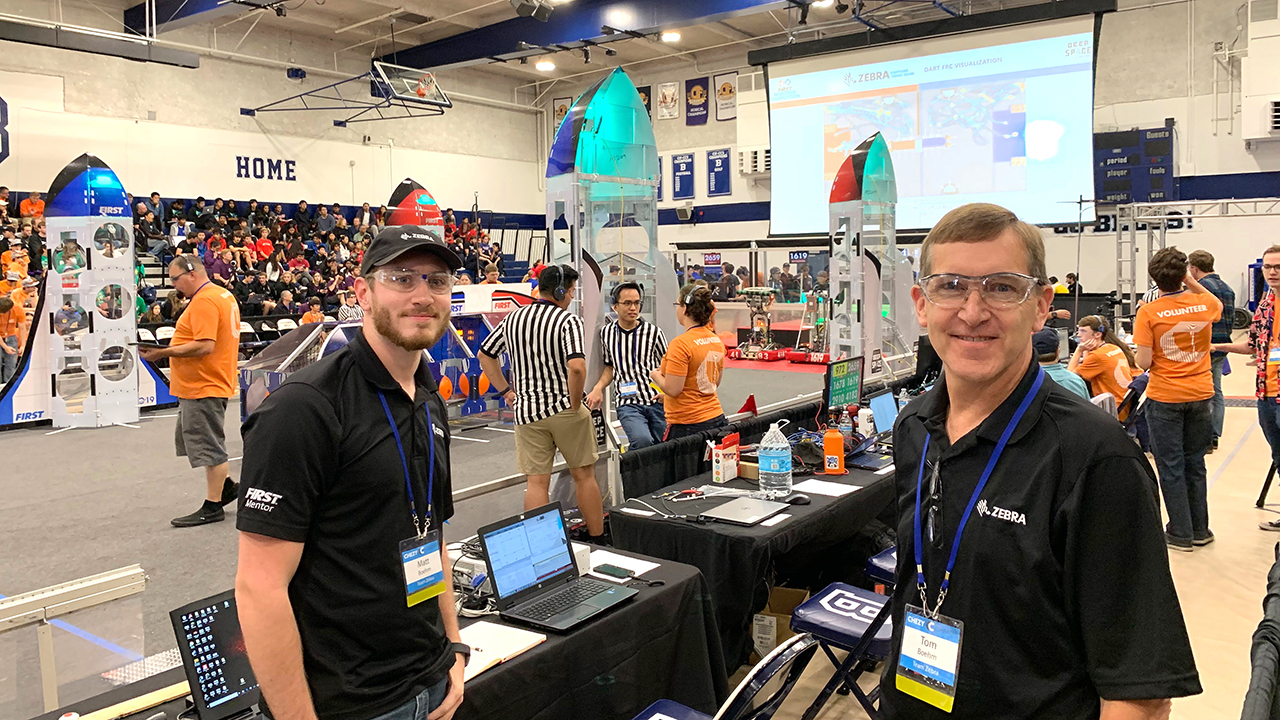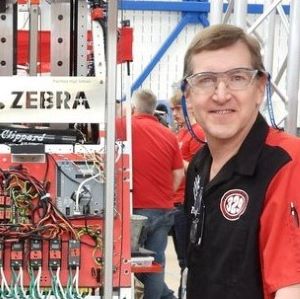
A Case for Innovation: Enabling FIRST Robotics Competition Students to Explore their Edge
Henry Ford is rumored to have once said, “If I had asked people what they wanted, they would have said faster horses.” You’ve probably heard this before, as it’s been murmured by many an executive, entrepreneur, futurist and innovator. The quote is often used to highlight the nature of innovation and, more specifically, the barriers to adoption that challenge us to ask “why” innovation is necessary. Why create a car when all you need is a faster horse? As obvious as the answer seems now, it wasn’t back then. Ford made a name for himself answering that question. Though some may have initially undervalued his drive for innovation – deeming the automobile excessive or unnecessary – time tends to reveal the true purpose and significance of continuous innovation.
Zebra’ collaboration with FIRST® is a great modern-day example. Like Ford, we weren’t shooting for faster horses when we embarked on our journey with the organization in 1999. We wanted to foster innovation among youth and help them demonstrate why businesses should transition from “horses” to “cars” to achieve new efficiencies and improve future outcomes.
Yet, unlike Ford, we weren’t aiming to build a better or faster full-size automobile. Instead, we were (and still are) seeking to advance the development of smaller-scale robotics innovations that collaborate with humans to help students foster a burgeoning interest in STEM and improve gameplay in FIRST competitions.
By giving FIRST teams access to advanced intelligence technologies that could inform engineering decisions and performance refinement, we can help young creative minds turn their technology-based ideas into marketable innovations that could become as significant to society as Ford’s cars – even if they initially garner a few question marks as to their purpose or benefit. (You can read more about our mission with FIRST in my last blog post.)
However, innovation can stall if the means by which you’re innovating becomes stale itself.
FIRST participants have the potential to find solutions to industries’ greatest operational challenges. Their inventions can open up a world of possibilities, just like Ford’s car. But in order to enable such innovation as mentors and technology partners, we at Zebra must too transition from “horses” to “cars.”
Let me explain…
A Case for “Cars”
We’ve always been confident that the same hardware and sensors used in Zebra MotionWorks™ real-time location solution (RTLS) could optimize FIRST gameplay. The data collected has a depth to it that can be used to help break down complex games and strategies into easier-to-absorb concepts for those who are new to FIRST, particularly those watching competition in person and via live streams. It can also provide individual teams with in-depth opportunities for descriptive, prescriptive and predictive analytics which they can apply to better their own robots. Additionally, the utilization of location data allows teams to assess future alliance partners and opponents and develop or refine their own game strategies.
We just needed to prove its value to the FIRST community across the U.S. and around the world, which we have successfully done, I’m proud to announce today. (More on that in a minute.) However, creating a portable system that easily allows for widespread RTLS utilization in FIRST has been akin to the challenges that Ford faced early on. We haven’t gotten to where we are now without overcoming a few obstacles. That’s because optimizing any technology’s conceptual application in a real-world setting – and proving that it’s worthy of full-scale adoption – takes time, patience and “failure.”
When we first debuted the application of our location solutions for FIRST at the Half Hollow Hills Invitational competition, an off-season FIRST Robotics Competition event in October 2017, all hands were on deck. There were nearly 10 Zebra employees present to set up and run the solution. However, we had to manually start and stop the collection of match data and then upload it all to a web hosting location to make it publicly available for teams’ utilization – which wasn’t happening in real time. (Not ideal.) And, while Zebra is a global company and we are passionate about providing our expertise wherever and whenever possible, our attendance at every FIRST event to manage this system is not realistic. Besides that, we never wanted our RTLS solution for high school robotics competitions to be so complicated that having an expert on hand was necessary to utilize it.
So, we got to work. We created and refined a RTLS data acquisition and processing application built specifically for FIRST and integrated with the organization’s official Field Management System (the electronics core of a FIRST Robotics competition that encompasses both hardware and software). This allows for the automated collection and uploading of match data to the cloud for global accessibility by participants.
We also worked with the RoboSports Network (RSN) to share the resulting data on its live feed to supplement commentary. (RSN live-streams coverage of many FIRST Robotics competitions.)
We then brought the system to the Chezy Champs Robotics Competition and the Indiana Robotics Invitational, two premier off-season events, to trial setup and maintenance with fewer and fewer Zebra employees at each event.
In October of 2019, Zebra shipped a complete RTLS system to Michigan for the Bloomfield Girls Robotics Competition, another off-season event. FIRST students and mentors picked it up, set it up, ran it and returned it – no Zebra employees involved!
This seamless out-of-box experience marked an important milestone for the future of this Zebra MotionWorks-based solution at FIRST competitions. Previously, at least one Zebra employee had to be present for setup and operation. In Michigan, just two weeks later, the solution was handled by FIRST students and mentors from arrival to departure. Eliminating the need for a Zebra location solutions expert onsite to manage setup and troubleshooting has removed a significant barrier to widespread adoption.
“Actionable Intelligence” for Everyone
The off-season has been our sweet spot for RTLS thus far, but it hasn’t been our only spot. We supplied the MotionWorks system at both of the SBPLI Long Island Regional Competitions in 2019 and intend to do so again in 2020.
We are also pleased to announce that we will be providing even more systems across the United States every year, beginning with the 2020 FIRST Robotics Competition season. This will allow Zebra to provide competition data on robot movements to over 750 teams in 2020, allowing them to more strategically choose alliances and identify problem areas using heatmap-derived insights – and that’s just to start. There are a number of ways that teams can apply RTLS analytics during robotics engineering and training, and we expect gameplay to be optimized on an entirely new level. Stay tuned for updates on RTLS utilization and outcomes in future Your Edge blog posts.
(Editor’s Note: You can subscribe to weekly blog updates here to stay in the know.)
The “Purpose” of Zebra’s FIRST Partnership: Driving Innovation
You may be asking why Zebra has felt compelled to expand its relationship with FIRST over the years and why we put so much effort into refining an RTLS solution for high school robotics competitions. The answer is simple:
Just as FIRST prides itself in being about “More Than Robots,” Zebra’s technological significance expands far beyond printers and barcode scanners.
We are shaping the “systems of reality” – the enterprise intelligence platforms – that will serve as the foundation of future technology innovation. Our pioneering efforts span from artificial intelligence to intelligent automation, with both our hardware and software solutions delivering significant outcomes for customers and consumers (including yourself) every day. As such, we’re in a rare and privileged position to influence the next generation of innovators.
For example, we’re ecstatic that we can enable students to leverage the exact same track-and-trace technology being used with MRI machines, in automotive manufacturing factories and in every NFL stadium today to strengthen the skill sets and deliver the intelligence they’ll need to innovate for the future. The confluence of our technology, our commitment to Corporate Social Responsibility and the brilliance of FIRST students will help us do even more for the next generation of builders, doers and problem solvers.

Tom Boehm
Tom Boehm has over 35 years of engineering experience spanning several industries, and he has been with Zebra for over 25 of those years. In his current role as a software engineer in Zebra’s Data Capture Solutions (DCS) Custom Products group, Mr. Boehm responds to customer requests for unique and sellable new features from Zebra’s scanner product lines.
Prior to this position, he spent many years as a software engineer in Zebra’s DCS standard product group and briefly supported Zebra’s Enterprise Mobile Computing (EMC) group. He also spent about a decade teaching at the university level.
Mr. Boehm holds a BS in Chemical Engineering from The Cooper Union and an MS in Computer Science from the Polytechnic Institute of NY.




